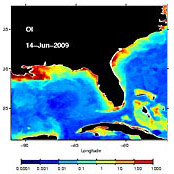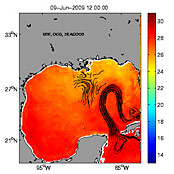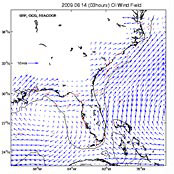Sea surface temperature (SST) data from AVHRR, TMI, and GOES products are merged to produce a cloud-free satellite SST field for the SEACOOS domain using optimal interpolation. The method is described in He et al. (2003).
A gapless Chl-a product for the SEACOOS domain from a composite of daily MODIS Chl-a images, with gaps from clouds filled and the image smoothed using optimum interpolation.
Drifter trajectories over the Gulf of Mexico are calculated from geostrophic surface currents. The absolute sea surface height (SSH), composed of Sea Surface Anomaly from the CLS Space Oceanography Division and a mean SSH from HYCOM, is used to calculate the geostrophic currents. The drifter trajectories are superimposed to our OI SST product.
Optimal Interpolation (OI) is used to merge the NCEP Eta Data Assimilation System with in situ measurements from USF and NDBG to generate a more realistic wind field.





